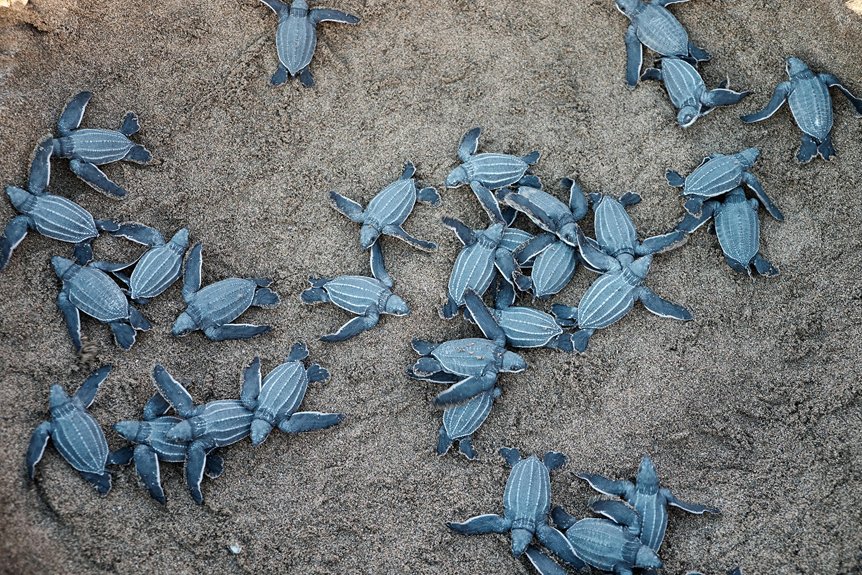If you’re seeking premier sea turtle nesting beaches near Paphos, Cyprus offers five exceptional sites. Lara Bay, Pissouri Beach, Sirena Bay, Kalamies Beach, and Geroskipou Beach provide critical habitats for endangered green and loggerhead turtles. These meticulously protected coastal ecosystems feature soft sandy substrates, minimal human intervention, and strategic conservation efforts. Each location offers unique microenvironmental conditions supporting turtle reproductive cycles. Explore further to uncover the intricate marine sanctuaries awaiting discovery.
Key Takeaways
- Lara Bay offers the most comprehensive sea turtle conservation experience near Paphos, featuring systematic monitoring of green and loggerhead turtle populations by the Lara Bay Turtle Conservation Station.
- Pissouri Beach provides an exceptional secluded nesting ground with protected habitats and minimal coastal development, ensuring optimal reproductive conditions for endangered sea turtle species.
- Sirena Bay delivers an intimate turtle watching destination with controlled nesting areas, calm waters, and focused conservation efforts during the May to August breeding season.
- Kalamies Beach represents a meticulously protected sanctuary with restricted access zones, scientifically-guided conservation programs, and opportunities to observe endangered green and loggerhead turtle nesting sites.
- Geroskipou Beach maintains a pristine coastal ecosystem with soft sandy substrates, systematic nesting zone monitoring, and controlled observation areas for witnessing turtle hatchling emergence near Paphos.
Lara Bay: A Premier Sea Turtle Conservation Site
While nestled along the rugged Akamas Peninsula, Lara Bay emerges as a vital sanctuary for endangered sea turtle species. You’ll discover one of the most significant turtle friendly beaches near Paphos, where green and loggerhead sea turtles establish pivotal nesting grounds. The Lara Bay Turtle Conservation Station meticulously monitors and protects these delicate marine habitats, implementing strategic conservation protocols to guarantee species survival.
When you visit, you’ll encounter a remote coastal environment characterized by pristine landscapes and challenging terrain. The conservation team systematically documents nesting sites, tracks hatchling emergence patterns, and facilitates controlled release mechanisms for juvenile turtles. Your potential observation might include witnessing remarkable reptilian reproductive cycles, though sightings aren’t assured.
The bay’s strategic geographic positioning and minimal human interference create an ideal microenvironment for sea turtle propagation. Its clear waters, undisturbed shoreline, and dedicated scientific management render Lara Bay an exceptional marine conservation site with significant ecological importance.
Pissouri Beach: Hidden Turtle Nesting Grounds
Nestled along the southern coastline of Cyprus, Pissouri Beach represents a critical yet understudied habitat for sea turtle conservation near Paphos. Its secluded landscape and minimal human intervention create a suitable environment for marine reptile reproduction.
Key characteristics of this ecological sanctuary include:
- Protected nesting sites with minimal anthropogenic disturbance
- Low-density coastal development preserving natural habitat integrity
- Strategic geographical positioning facilitating reproductive cycles
- Nuanced microenvironmental conditions supporting successful turtle hatching
Scientific observations suggest Pissouri Beach provides substantive nesting grounds, though definitive turtle sightings remain probabilistic. The beach’s topographical features-characterized by undisturbed sandy terrain and limited human footprint-generate conducive reproductive conditions for endangered sea turtle populations.
While not as prominently documented as other Cypriot turtle habitats, Pissouri Beach’s ecological significance cannot be understated. Its potential as a conservation site warrants continued systematic research and environmental monitoring to understand and preserve marine reptilian reproductive dynamics.
Sirena Bay: Intimate Turtle Watching Destination
Following the ecological exploration of Pissouri Beach’s potential turtle habitats, Sirena Bay emerges as another compelling marine conservation site near Paphos. This secluded coastal ecosystem provides a suitable environment for endangered sea turtle species, specifically green and loggerhead turtles, during their critical nesting period from May to August.
The bay’s topographical and environmental characteristics-calm, clear waters and minimal anthropogenic disturbance-create a favorable breeding ground for marine reptilian reproduction. Conservation efforts at Sirena Bay focus on systematic nest monitoring, hatchling protection protocols, and targeted public education initiatives designed to mitigate human-induced ecological disruptions.
While turtle sightings cannot be guaranteed, the site offers a scientifically rigorous and ecologically responsible opportunity to observe these marine species in their natural reproductive habitat. Visitors can potentially witness the intricate nesting behaviors of sea turtles, contributing to broader understanding of their complex biological processes and conservation needs.
Kalamies Beach: Secluded Turtle Sanctuary
How do marine conservationists define an ideal sea turtle nesting habitat? Kalamies Beach near Protaras exemplifies the quintessential sanctuary: undeveloped, secluded, and meticulously protected during critical nesting seasons from May to October.
Emotional engagement highlights:
- Witness endangered green turtles and loggerheads traversing pristine coastal landscapes
- Observe carefully marked nesting sites revealing nature’s delicate reproductive strategies
- Experience restricted access zones preserving essential marine ecosystem dynamics
- Participate in scientifically-guided conservation educational programs
The beach’s topographical characteristics provide perfect conditions for sea turtle reproduction. Its restricted access minimizes human interference, allowing these marine reptiles uninterrupted breeding processes. Conservationists strategically mark nesting locations, enabling controlled observation without disrupting critical ecological interactions.
Visitors can engage with specialized tours designed to illuminate sea turtle conservation efforts, transforming passive observation into an immersive scientific experience. The beach’s ecological significance extends beyond aesthetic appeal, representing a vital reproductive habitat for endangered marine species.
Geroskipou Beach: Coastal Turtle Haven
Just northwest of Kalamies Beach, Geroskipou Beach emerges as another premier sea turtle nesting site near Paphos, offering marine biologists and conservation specialists a rich ecological landscape for studying endangered marine reptile reproduction.
You’ll discover a meticulously preserved coastal ecosystem that provides critical habitat for green and loggerhead turtle species. The beach’s morphological characteristics-including soft, sandy substrates and minimal human intervention-create ideal conditions for successful marine turtle reproduction. Conservation teams systematically mark and monitor nesting zones, enabling precise tracking of reproductive patterns and hatchling survival rates.
During nesting seasons, you can observe scientifically marked nest sites where hundreds of turtle hatchlings emerge, traversing their initial marine trajectory. These controlled observation zones allow eco-tourists and researchers to witness rare reproductive behaviors without disrupting delicate ecological processes.
Geroskipou Beach represents a significant research and conservation platform, demonstrating Cyprus’s commitment to marine biodiversity preservation.
Frequently Asked Questions
Where to See Turtles in Cyprus Near Paphos?
You’ll find turtle-viewing opportunities along Cyprus’s coastal regions, with strategic locations offering ideal marine reptile observation. Near Paphos, examine Sirena Bay and Kalamies Beach during nesting season (May-August). The Spot Turtle Project at Alagadi provides scientifically-guided hatchling releases. While Paphos center lacks guaranteed sightings, you’ll potentially observe sea turtles traversing rocky seafront areas and harbor zones, with Pissouri Beach presenting additional protected nesting habitats 30 minutes from urban centers.
Where Is Turtle Beach, Paphos?
Like a hidden treasure map, Paphos doesn’t actually feature a dedicated “Turtle Beach”. You’ll find potential turtle-nesting sites along beaches east of the city, such as Sirena Bay and Kalamies Beach. These coastal ecosystems provide critical habitats for endangered green and loggerhead turtles during summer reproductive cycles. While turtles occasionally populate regional marine environments, specific beach locations require careful ecological navigation.
Where to See Baby Turtles in Cyprus?
You’ll find ideal sea turtle hatchling observation sites along Cyprus’s eastern and northern coastal regions. Sirena Bay and Kalamies Beach in Protaras offer prime viewing from late July to September. The Alagadi and Akdeniz beaches in Northern Cyprus’s Kyrenia district provide exceptional hatchling emergence opportunities. The Spot Turtle Project organizes guided excursions, enabling you to witness these remarkable marine reptile reproductive events with scientific precision.
What Month Can You See Turtles in Cyprus?
Like waves rhythmically lapping the shore, sea turtle activity peaks in Cyprus from May to October. You’ll find ideal viewing periods between late July and September, when hatchlings emerge from sandy nests. Professional conservation groups like the Spot Turtle Project facilitate scientific observation of Caretta caretta reproduction. Peak nesting occurs during summer months, with adult females depositing clutches and juvenile turtles subsequently emerging along coastal habitats.
Conclusion
You’ve traversed Cyprus’s coastal ecosystems, witnessing sea turtle reproductive habitats characterized by precise geomorphological and ecological parameters. These nesting grounds represent critical herpetological microcosms where Caretta caretta specimens perpetuate generational survival strategies. While seemingly tranquil, these beaches are evolutionary battlegrounds where genetic persistence confronts anthropogenic disruption. Your newfound comprehension transforms casual observation into scientific appreciation, revealing the delicate choreography of marine reptilian reproductive cycles.

Meet Natalie, who has lived on Cyprus for the last 10 years. She loves exploring the beautiful nature of the island, like quiet forests and untouched beaches. Natalie has lots of cool experiences to share. Join her as she talks about her adventures in Cyprus.

